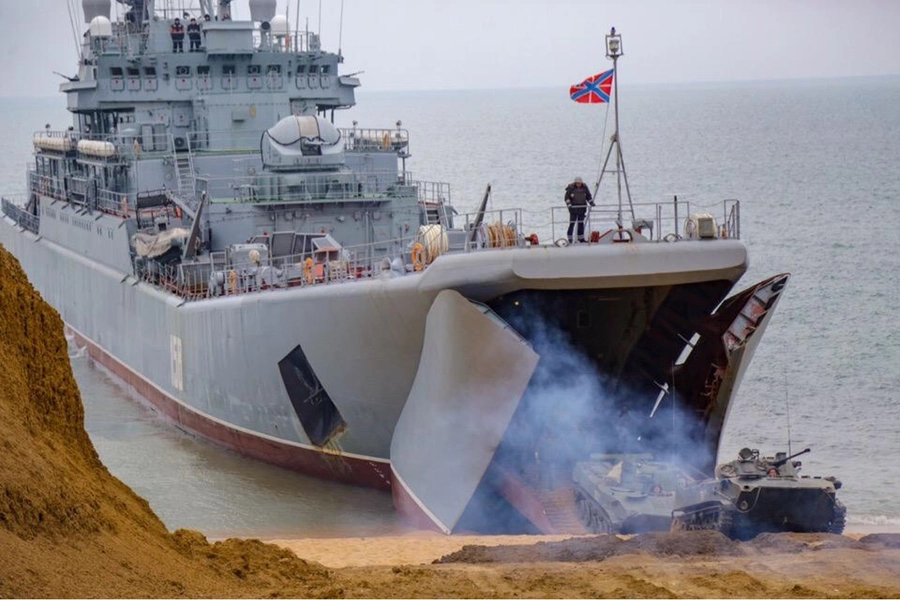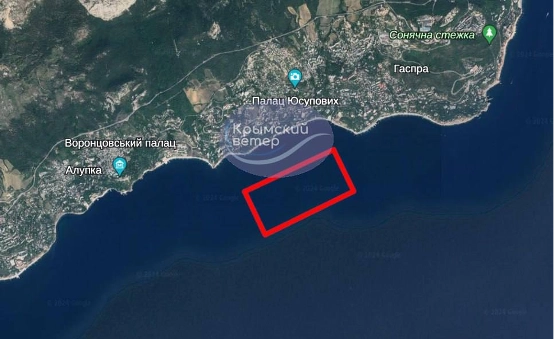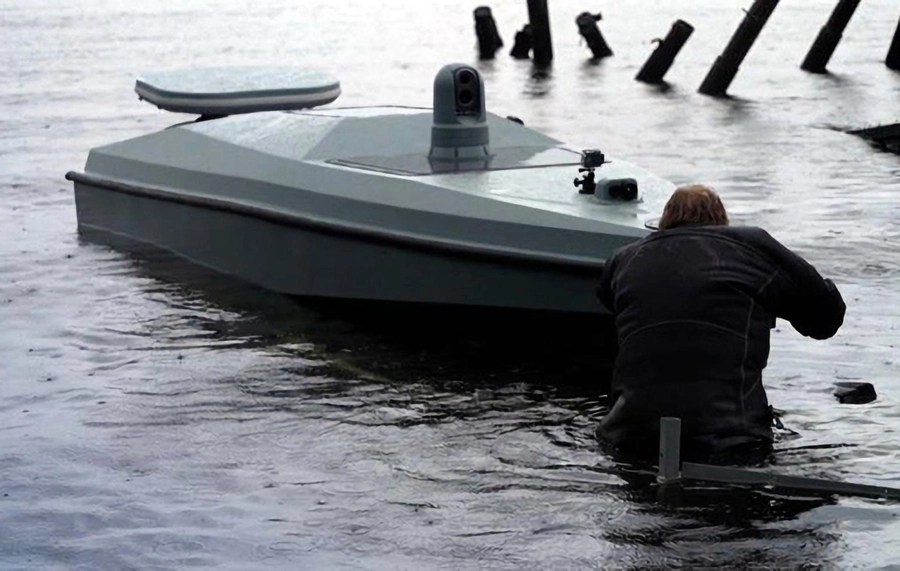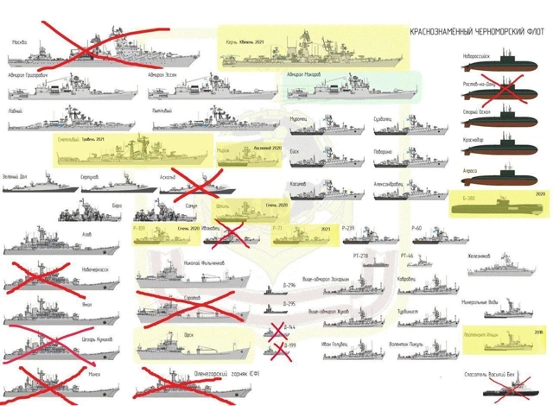A swarm of Ukrainian robot drones on Wednesday morning sank one of the Russian Black Sea Fleet’s heaviest warships still afloat, in another blow to Kremlin naval power in the region.
At least three attack boats loaded with explosives and remotely controlled by operators from Ukrainian Defense Ministry’s Main Directorate for Intelligence (HUR), struck the heavy assault ship Caesar Kunikov as the vessel was close offshore from the Crimean resort town of Alupka.
JOIN US ON TELEGRAM
Follow our coverage of the war on the @Kyivpost_official.
Undated image of the heavy assault ship Caesar Kunikov landing naval infantry aboard BTR armored personnel carriers during pre-war exercise.
Initial strikes took place shortly after 6 a.m. before sunrise, and the vessel was in flames. It apparently sank an hour later, dozens of still images and video clips recorded from nearby beaches and made public on social media showed.
In a three-minute, edited video published by HUR, low-lying attack boats mounted with cameras circle the Russian warship in choppy seas, before launching kamikaze attacks.
The Caesar Kunikov appears to be sailing straight with lights lit. Crew members standing on the deck are visible. The video shows at least six individual attack boats approaching to less than 100 meters toward starboard/right side of the Russian ship.
It is not clear from the HUR video how many of the Ukrainian robot boats actually hit the Russian ship. One sizable detonation amidships is shown. Later attacks or close approaches by drones shift to the port/left side of the warship. Some attack boats make zig-zag approaches.

Trapping Drones: Fishing Nets from Denmark Help Ukraine’s Soldiers Survive
During one probably successful strike, Russian rifle or machine gun fire hits water around the drone, with the robot boat’s bow less than 10 meters away from the assault ship before the video cuts off.
A later section of the HUR images shows an attack boat racing towards its target and aiming at already destroyed superstructure amidships of the Russian vessel. No defensive fire is visible. The last video section shows the warship lying on its side and apparently sinking.
Images flooding local media showed that the Russian assault ship was sunk in full view of the city Alupka, a densely populated town in the center of the Crimean “Rivera” resort region.
Map graphic by the pro-Ukraine Crimea information platform Krymsky Veter showing the location of the Caesar Kunikov’s attack and sinking.
Some video of heavy explosions taking place aboard the Caesar Kunikov at about 7:15, more than an hour after the first attacks, appeared to have been recorded from a beach nearby. Geolocators by midday had settled on the probable sinking site at 44.3747, 33.8822, south of Parkove village.
Russian law bans the placement of combat-related information on the internet, but the rule is sometimes ignored. Local officials reported explosions audible as far away as Yalta some 10 kilometers away. In the town Simeiz early-risers messaged each other about small arms fire coming from the direction of the sea.
Russian Ka-27 helicopters were visible above the sinking site throughout the morning, and local news showed ambulances driving through the district center, Yalta, towards Alupka.
As designed, the Caesar Kunikov would carry a full crew of 87 sailors and officers. Black Sea temperatures in February usually are slightly above zero Centigrade, making survival for an unprotected man in the water unlikely for more than 30 minutes.
A Soviet-era amphibious assault warship weighing in at about 4,000 tons, the Cesar Kunikov, along with eight other vessels of its class, landed thousands of troops and heavy weapons along Ukraine’s Black Sea coast at the outset of Russia’s February 2022 full-scale attack against its southern neighbor. At the time the Russian navy was able to operate across the Black Sea without effective Ukrainian interference.
Kyiv’s later acquisition and deployment of long-range anti-ship missiles, cruise missiles, even ballistic missiles, and, most recently, seagoing kamikaze drones, has steadily degraded Russian naval capacity in the Black Sea. Of the nine Rostopcha-class assault ships on Black Sea Fleet balance since the start of the war, including the Caesar Kunikov’s Wednesday sinking, five have been destroyed.
According to a HUR statement, MAGURA V5 boats sank the Caesar Kunikov.
The Ukrainian-developed seaborne drone has a maximum speed of 78 kph can carry up to 320 kg of explosives. It attacks by ramming into a target.
Ukrainian special operator prepares a MAGURA V5 robot boat for launch in an undated image published by the AFU.
Kyiv’s first reported successful MAGURA robot boat raid took place in November 2023 when the kamikaze drones blew up a pair of small Russian landing craft in the Crimean port city of Chornomorske. On Feb. 4 a wave reportedly of six MAGURAs cornered and sank the Russian missile corvette Ivanovets in Ozero Donuslav, a bay on the southwest coast of Crimea.
Wednesday’s destruction of the Caesar Kunikov, a warship 10 times the size of the Ivanovets, marked the first confirmed successful MAGURA drone attack in open seas, and the most significant kill by the kamikaze speed boat weapon to date.
Image of all the warships in the Russian Black Sea Fleet battle updated to show the Caesar Kunikov (far left, fourth from bottom) newly sunk. Ships shaded yellow are in long-term maintenance. Since Russia’s Feb. 24, 2022 invasion of Ukraine the Kremlin has lost roughly half of its operational warships and was forced out of its main naval base in Sevastopol.
It was not clear what mission the Russian warship was performing when hit by the Ukrainian attack boats. In past months, according to HUR statements, the Russian military had used drop-ramp attack ships like the Caesar Kunikov to transport men and supplies from the Russian mainland to the Crimean Peninsula by sea, because of the risk of Ukrainian long-range strikes against Russian land-based military supply routes.
Dmitriy Peskov, spokesman for Russian President Vladimir Putin, was asked by a Moscow reporter if the Wednesday sinking meant that Kremlin naval capacity in the Black Sea was possibly in jeopardy. He said that he had no comment and that questions like that should be addressed to the Russian military.
You can also highlight the text and press Ctrl + Enter















